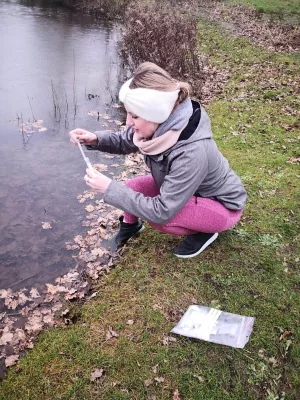
Karolina Brylka
Doctoral student

Biogenic silica accumulation and diatom assemblage variations through the Eocene-Oligocene Transition : A Southern Indian Ocean versus South Atlantic perspective
Author
Summary, in English
It is widely interpreted that there is a significant link between climate cooling at the Eocene-Oligocene Transition
(EOT; ~34 Ma) and subsequent diatom proliferation in the world’s oceans during the mid to late Cenozoic. Yet,
our understanding of biogenic silica flux through the EOT interval is based on limited data from a few sites, and
there are many complications in making a meaningful comparison based on biogenic silica concentration data
generated using different techniques. Here, we present new biogenic opal flux and diatom assemblage records
across EOT from Ocean Drilling Program Site 748 (Southern Kerguelen Plateau, southern Indian Ocean), in
addition to new biogenic opal flux records from the South Atlantic (Deep Sea Drilling Project Site 511, Falkland
Plateau and Ocean Drilling Program Site 1090, Agulhas Ridge). Observed opal flux shifts and variability at Site
748 are consistent with published data from nearby Site 744; both sites show considerable shifts in biogenic opal
accumulation rates corresponding to shifts in published benthic oxygen isotope records through the EOT. In
contrast, our new opal flux record for Site 511, derived from biogenic opal concentration measurements via
spectrophotometry, differs from the published record derived from insoluble residues, whereas new data
generated for Site 1090 are generally consistent with previously published flux reconstructions. The South
Atlantic biogenic opal flux records, however, are dissimilar from one another, and both are dissimilar from the
Southern Indian Ocean records. Also, the taxonomic composition of the diatom assemblages from Sites 511, 748
and 1090 display considerable differences, with hemiauloids and rhizosolenids – generally inferred as indicative
of oligotrophic conditions – being the dominant diatoms at the Southern Kerguelen Plateau (Site 748). Published
records show that hemiauloid taxa are absent from the earliest Oligocene interval at Site 1090, which is widely
seen as a record of deposition from nutrient-rich waters sustaining abundant diatom assemblages. These differences
in diatom assemblages testify to regional differences in nutrient concentrations. In particular, the timing
of biogenic opal flux pulses between Sites 1090 and 748 imply a shift in the locus of opal deposition to areas
further south in the Southern Ocean across the EOT, likely related to proto-ACC development and strengthening
of frontal boundaries. Thus, combined geochemical and micropaleontological evidence points to a regionally
variable rather than a global, unified opal flux response to climate cooling through the Eocene-Oligocene
Transition.
(EOT; ~34 Ma) and subsequent diatom proliferation in the world’s oceans during the mid to late Cenozoic. Yet,
our understanding of biogenic silica flux through the EOT interval is based on limited data from a few sites, and
there are many complications in making a meaningful comparison based on biogenic silica concentration data
generated using different techniques. Here, we present new biogenic opal flux and diatom assemblage records
across EOT from Ocean Drilling Program Site 748 (Southern Kerguelen Plateau, southern Indian Ocean), in
addition to new biogenic opal flux records from the South Atlantic (Deep Sea Drilling Project Site 511, Falkland
Plateau and Ocean Drilling Program Site 1090, Agulhas Ridge). Observed opal flux shifts and variability at Site
748 are consistent with published data from nearby Site 744; both sites show considerable shifts in biogenic opal
accumulation rates corresponding to shifts in published benthic oxygen isotope records through the EOT. In
contrast, our new opal flux record for Site 511, derived from biogenic opal concentration measurements via
spectrophotometry, differs from the published record derived from insoluble residues, whereas new data
generated for Site 1090 are generally consistent with previously published flux reconstructions. The South
Atlantic biogenic opal flux records, however, are dissimilar from one another, and both are dissimilar from the
Southern Indian Ocean records. Also, the taxonomic composition of the diatom assemblages from Sites 511, 748
and 1090 display considerable differences, with hemiauloids and rhizosolenids – generally inferred as indicative
of oligotrophic conditions – being the dominant diatoms at the Southern Kerguelen Plateau (Site 748). Published
records show that hemiauloid taxa are absent from the earliest Oligocene interval at Site 1090, which is widely
seen as a record of deposition from nutrient-rich waters sustaining abundant diatom assemblages. These differences
in diatom assemblages testify to regional differences in nutrient concentrations. In particular, the timing
of biogenic opal flux pulses between Sites 1090 and 748 imply a shift in the locus of opal deposition to areas
further south in the Southern Ocean across the EOT, likely related to proto-ACC development and strengthening
of frontal boundaries. Thus, combined geochemical and micropaleontological evidence points to a regionally
variable rather than a global, unified opal flux response to climate cooling through the Eocene-Oligocene
Transition.
Department/s
- Quaternary Sciences
- Lithosphere and Biosphere Science
Publishing year
2024
Language
English
Publication/Series
Palaeogeography, Palaeoclimatology, Palaeoecology
Volume
636
Document type
Journal article
Publisher
Elsevier
Topic
- Geochemistry
Keywords
- Biogenic opal
- Mass accumulation rates
- diatoms
- Paleogene
- Mass accuEocene-Oligocene transition
- Southern Ocean
Status
Published
ISBN/ISSN/Other
- ISSN: 0031-0182

